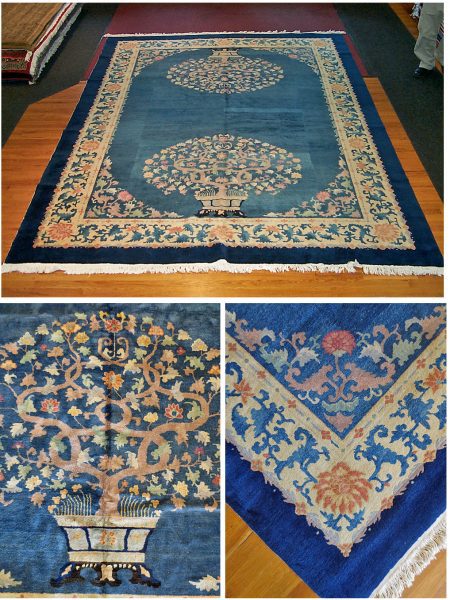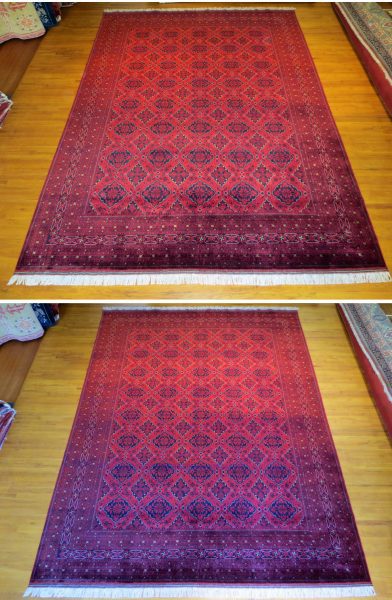Window Watch 8/31 Art of the Outdoors/Indoors & Tribal Energy
Posted on September 3rd, 2013 by Joshua Kebabian
WINDOW LEFT
The charming antique Chinese “Fette” displayed in WINDOW LEFT measures 9.3 x 11.10. This Chinese piece was hand-knotted in China using vegetally dyed wool, circa 1920. The Fette pieces are finely woven and contain the timeless, traditional Chinese designs. “It has been the genius of the Chinese people to preserve unchanged the same art spirit from generation to generation. The same art motives which flourished in the earliest dynasties stirred the artists of the later dynasties.” Ferguson, John C. Outlines of Chinese Art.
This picturesque Fette contains the classic Chinese colors of blue, tan, apricot and yellow. The twin dominating elements are Penzai or “potted scenery”. Penzai are living sculptures or three-dimensional poetry depicting the spirit of nature. The birth of the Penzai is traced back to legends of Daoist persons who had the ability to shrink landscapes into small vessels dating back to the 3rd & 4th centuries.
The flower of flowers for Chinese rug decoration is the lotus. The lotus is the sacred flower of the Buddhists and represents immortality, the symbol of purity and the special flower of the gods. It is celebrated not only for its beauty, but also its functionality (like a Kebabian rug!). The lotus seeds and roots are used as articles of food. The cloud design, rarely seen outside of Asiatic countries and a favorite element of Chinese carpets are found throughout the main border and the four inner quadrants.
This charming “Fette” brings the “art of the outdoors” Penzai, indoors with an allure and sophistication for your home.
WINDOW RIGHT
The strong and bold very fine Afghan displayed in WINDOW RIGHT measures 9.10 x 12.5. This carpet was hand-knotted by Turkmen women in northern Afghanistan using rich saturated reds, deep navy blues and citron with worsted Belgian wool. This very fine Afghan has the definitive broad webbing at the ends and the large octagonal shaped figures placed in perpendicular rows. Like the majestic and fearless landscape of Afghanistan, the designs and colors are strong and intense.
The top image of the carpet is the Light Side (with the nap )and radiates an orange hue. If my feet are facing the carpet and I “rough up” the carpet as I bring my hand towards me, it is the side which the light reflects off, i.e. the Light Side(with the nap).
The bottom image of this bold carpet is the Dark Side (into the nap). If my feet are facing the carpet and I “pet” or “smooth” the carpet as I bring my hand towards me, it is the side that when looking into the carpet the light is absorbed, i.e. the Dark Side (into the nap). It is also the side that as the weaver is tying the knot he/she cuts the wool in a downward motion creating the direction of the nap.
No rug better demonstrates two views than the very fine Afghans. You can really get your Yin & Yang on!
The bold and primitive very fine Afghans would look absolutely stunning in a muted setting of grey or earth tones. The tribal energy would bring a room to life!
Sources: Oriental Rugs, Walter A. Hawley, Oriental Rugs, John Kimberly Mumford


